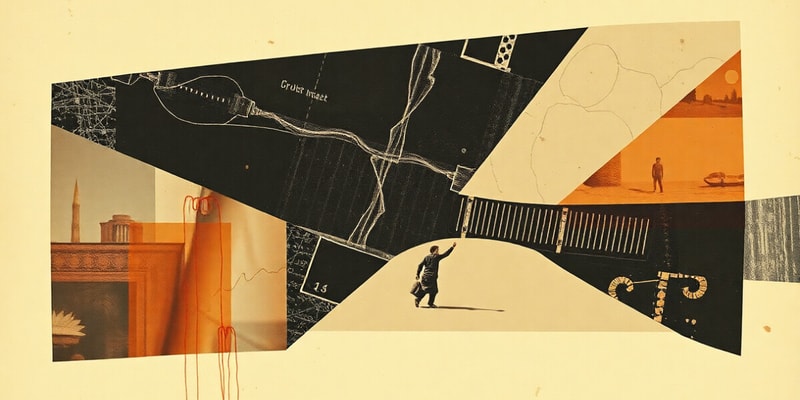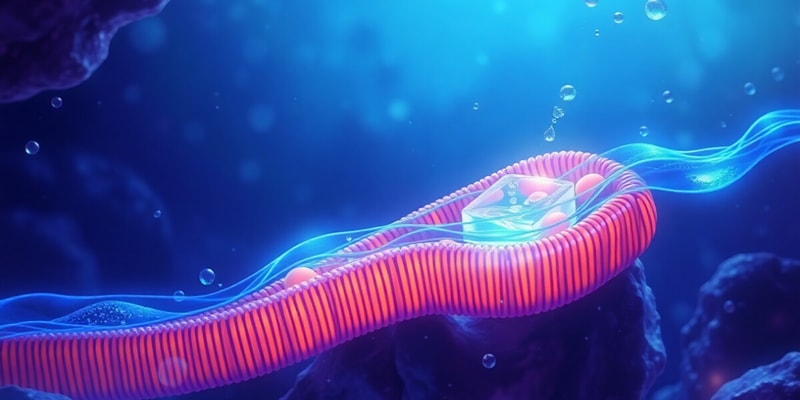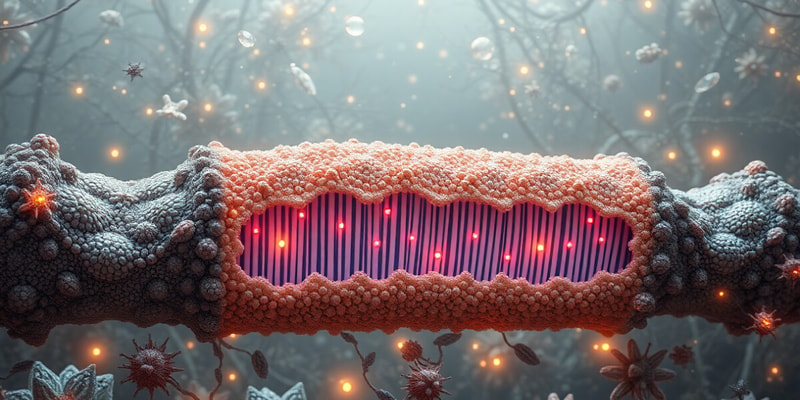Podcast
Questions and Answers
The study of ______ is essential for understanding Systems & Integrated Physiology.
The study of ______ is essential for understanding Systems & Integrated Physiology.
Physiology
The ______ is a mechanism that facilitates the absorption of glucose.
The ______ is a mechanism that facilitates the absorption of glucose.
Na+/Glucose cotransporter
Bulk uptake of water is different from ______ water uptake.
Bulk uptake of water is different from ______ water uptake.
regulated
One simple observation in Physiology is credited with saving the lives of over ______ children.
One simple observation in Physiology is credited with saving the lives of over ______ children.
Signup and view all the answers
Nerve ______ is an important aspect of the integrated physiology system.
Nerve ______ is an important aspect of the integrated physiology system.
Signup and view all the answers
The body is organized into various ______, including systems and tissues.
The body is organized into various ______, including systems and tissues.
Signup and view all the answers
There are a total of ______ systems in human physiology.
There are a total of ______ systems in human physiology.
Signup and view all the answers
Studying one aspect of Physiology can help to ______ other areas.
Studying one aspect of Physiology can help to ______ other areas.
Signup and view all the answers
Insulin is a type of _____ that regulates blood sugar levels.
Insulin is a type of _____ that regulates blood sugar levels.
Signup and view all the answers
The _______ is responsible for synthesizing proteins within the cell.
The _______ is responsible for synthesizing proteins within the cell.
Signup and view all the answers
During ________, cells take in substances from their external environment.
During ________, cells take in substances from their external environment.
Signup and view all the answers
The _____ is an organelle responsible for breaking down waste materials and cellular debris.
The _____ is an organelle responsible for breaking down waste materials and cellular debris.
Signup and view all the answers
The _______ transport process is key for glucose absorption in the intestines.
The _______ transport process is key for glucose absorption in the intestines.
Signup and view all the answers
Glucose must leave intestine & enter ______
Glucose must leave intestine & enter ______
Signup and view all the answers
Epithelial cells are joined by ______ junctions
Epithelial cells are joined by ______ junctions
Signup and view all the answers
The outside face of epithelial cells is referred to as the ______ surface
The outside face of epithelial cells is referred to as the ______ surface
Signup and view all the answers
Glucose concentration in the intestinal lumen is ______
Glucose concentration in the intestinal lumen is ______
Signup and view all the answers
If the diffusion coefficient (Dc) is greater than 0, solute will move by spontaneous ______
If the diffusion coefficient (Dc) is greater than 0, solute will move by spontaneous ______
Signup and view all the answers
Glucose cannot enter cells against its ______ gradient by diffusion
Glucose cannot enter cells against its ______ gradient by diffusion
Signup and view all the answers
Tight junctions can be ______ or leaky depending on their composition.
Tight junctions can be ______ or leaky depending on their composition.
Signup and view all the answers
Glucose is transported out of epithelial cells through the ______ membrane
Glucose is transported out of epithelial cells through the ______ membrane
Signup and view all the answers
Sodium levels are ______ in the lumen and high in the epithelial cells.
Sodium levels are ______ in the lumen and high in the epithelial cells.
Signup and view all the answers
If the permeability (P) is zero, a ______ protein is required for transport.
If the permeability (P) is zero, a ______ protein is required for transport.
Signup and view all the answers
The mechanism of glucose absorption is facilitated by the Na+/Glucose ______.
The mechanism of glucose absorption is facilitated by the Na+/Glucose ______.
Signup and view all the answers
Bulk uptake of water occurs via the ______ pathway.
Bulk uptake of water occurs via the ______ pathway.
Signup and view all the answers
Tight junctions in the small intestine and kidney tubules are described as being a bit ______.
Tight junctions in the small intestine and kidney tubules are described as being a bit ______.
Signup and view all the answers
Water is absorbed from the lumen to the interstitial fluid based on the presence of an ______ gradient.
Water is absorbed from the lumen to the interstitial fluid based on the presence of an ______ gradient.
Signup and view all the answers
In healthy individuals, the absorption of water is a ______ process.
In healthy individuals, the absorption of water is a ______ process.
Signup and view all the answers
Water flows down its concentration ______.
Water flows down its concentration ______.
Signup and view all the answers
H2O flows up an osmotic ______.
H2O flows up an osmotic ______.
Signup and view all the answers
The biggest medical breakthrough of the 20th ______ was significant for advancements in health.
The biggest medical breakthrough of the 20th ______ was significant for advancements in health.
Signup and view all the answers
Water is absorbed in the ______ of the gut through various mechanisms.
Water is absorbed in the ______ of the gut through various mechanisms.
Signup and view all the answers
Regulated water uptake differs from ______ water uptake in terms of control mechanisms.
Regulated water uptake differs from ______ water uptake in terms of control mechanisms.
Signup and view all the answers
The Na+/Glu Symporter allows glucose to enter the cell down its ______ gradient.
The Na+/Glu Symporter allows glucose to enter the cell down its ______ gradient.
Signup and view all the answers
Na+ is pumped out of the ______ membrane.
Na+ is pumped out of the ______ membrane.
Signup and view all the answers
Glucose leaves the epithelial cells via a ______.
Glucose leaves the epithelial cells via a ______.
Signup and view all the answers
Na+ must cross the apical membrane using the Na+/Glu ______.
Na+ must cross the apical membrane using the Na+/Glu ______.
Signup and view all the answers
The entry of Na+ and glucose creates a large osmotic ______ across the cell.
The entry of Na+ and glucose creates a large osmotic ______ across the cell.
Signup and view all the answers
Water enters the body through paracellular flow via 'leaky' tight ______.
Water enters the body through paracellular flow via 'leaky' tight ______.
Signup and view all the answers
Na+ enters the interstitial space via the Na+ ______ on the basolateral membrane.
Na+ enters the interstitial space via the Na+ ______ on the basolateral membrane.
Signup and view all the answers
The main effect of the transport processes is to absorb ______.
The main effect of the transport processes is to absorb ______.
Signup and view all the answers
The epithelial cells have ______ junctions that contribute to water flow.
The epithelial cells have ______ junctions that contribute to water flow.
Signup and view all the answers
The glucose uniporter facilitates the movement of glucose from inside the cell to the ______ space.
The glucose uniporter facilitates the movement of glucose from inside the cell to the ______ space.
Signup and view all the answers
Study Notes
Transport across cell membranes
- Glucose is absorbed from the intestine and into the bloodstream.
- Glucose must cross several cell membranes to get from the intestine to the bloodstream to the muscle cell.
- Epithelial cells are polarized and joined by tight junctions.
- Tight junctions are composed of varying proteins and can be "leaky" or "tight".
- Epithelial cells form a barrier to solutes and water.
- Na+/Glucose cotransporter is an active transport mechanism for glucose absorption.
Bulk Absorption of water
- Water is absorbed from the gut and kidney tubules via paracellular pathway.
- "Leaky" tight junctions in the small intestine and kidney tubules permit water absorption.
- Water moves with the osmotic gradient, which is maintained by the Na+/glucose cotransporter.
- The Na+/glucose cotransporter pumps sodium ions into the cell, creating a concentration gradient that pulls water into the cell.
Glucose Uptake in Cells
- Glucose is transported into the epithelial cells via the Na+/glucose cotransporter.
- Sodium ions (Na+) are pumped out of the epithelial cell using the Na+/K+ ATPase pump.
- Glucose leaves the epithelial cell via the uniporter on the basolateral side of the cell.
- This creates a continuous osmotic gradient that drives water absorption from the intestinal lumen into the interstital space.
Cellular Processes
- Exocytosis and endocytosis are two important cellular transport mechanisms.
- Exocytosis is the process of releasing substances from the cell.
- Endocytosis is the process of taking substances into the cell (such as bacteria, viruses, or LDL cholesterol).
- The lysosome is an organelle involved in endocytosis and exocytosis.
- Lysosomes contain digestive enzymes that can break down materials taken into the cell via endocytosis.
- Endocytosis and exocytosis are crucial for maintaining cellular homeostasis and function.
Medical Breakthrough
- The discovery of the Na+/glucose cotransporter is considered a major medical breakthrough of the 20th century.
- This discovery led to the development of oral rehydration therapy which has saved over 40,000,000 children from dehydration.
Physiology and Integrated Physiology
- Understanding the function of individual systems is essential for understanding overall physiology.
- Understanding transport across cell membranes is crucial for understanding how systems function.
- Physiology is a complex subject that integrates the functions of the many systems of the body to maintain homeostasis.
Studying That Suits You
Use AI to generate personalized quizzes and flashcards to suit your learning preferences.
Related Documents
Description
This quiz covers the transport of glucose and water across cell membranes, focusing on epithelial cells and their tight junctions. It examines mechanisms such as the Na+/Glucose cotransporter and how osmotic gradients facilitate absorption. Test your knowledge on cellular transport processes and their physiological significance.




